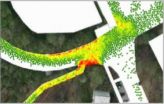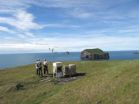(Press-News.org) For the last dozen years, scientists have known that minuscule strings of genetic material called small RNA are critically important to our genetic makeup. But finding out what they do hasn't been easy. Now a scientist from Michigan Technological University and his team have developed a way to turn off small RNAs and find out just how important they can be.
When it comes to inheritance, DNA is just the half of it. What we are is also driven by the epigenetic world of RNA: the countless, twisting molecules that DNA churns out. RNA in turn transforms the amino acid soup in our cells into the proteins that are us—and every other plant and animal on the planet, for that matter.
There's more than one kind of RNA, however. In addition to the long strings that make proteins, there are short, meddling snippets called small RNAs. Sometimes, they can attach to long RNA molecules and break them in two. That obviously has consequences for the organism, but exactly what role the thousands of different small RNAs play has been a puzzle.
Now, Guiliang Tang, an associate professor of biological sciences, has developed a way to put a single small RNA out of commission and observe what happens when it can't do its job.
To do this, Tang and his team threw a wrench into a well-understood process that controls leaf symmetry and the tendency of plants to grow upright.
First they synthesized a sequence of DNA that would make a custom-designed type of small RNA, called a small tandem target mimic, or STTM. Then they introduced their synthetic DNA in Arabidopsis, a plant often used in genetics research. Once in the Arabidopsis, the synthetic DNA began manufacturing many copies of the STTM.
Then all the little STTMs began locking onto strands of a specific type of RNA, right where the plant's small RNA would normally have cut them in two. That blocked its action, so the long RNA strands remained intact.
Furthermore, the procedure prompted the cell to destroy all of its own small RNAs that would normally have cut the RNA. Together, those two mechanisms allowed the long RNA to make its protein unabated.
The results were dramatic. The control Arabidopsis plants grew upward on a central stem with regularly shaped leaves and stems. The mutant plants were smaller, tangled, and amorphous.
Their method isn't limited to one small RNA involved in leaf symmetry in Arabidopsis.
"You can use this to study the function of any small RNA in the cell," says Tang.
In an online commentary, Plant Cell senior features editor Nancy Eckardt called their method "a highly effective and versatile tool" for studying the functions of small RNA.
Now, Tang hopes to find out how and why this procedure causes cells to destroy small RNA. And his wife and fellow researcher Xiaoqing Tang, an assisant professor of biological sciences, plans to use this technology to better understand type 2 diabetes.
INFORMATION:
Their work is funded by the National Science Foundation and described in the article "Effective Small RNA Destruction by the Expression of a Short Tandem Target Mimic in Arabidopsis," published Feb. 16 online in the journal Plant Cell. The lead authors of the paper are students who worked with Tang: Jun Yan, now a postdoctoral researcher at Purdue University, and Yiyou Gu, now an undergraduate at Nanjing Agricultural University, in China. Other coauthors are Xiaoyun Jia, Wenjun Kang and Shangjin Pan of the University of Kentucky and Xuemei Chen of the University of California at Riverside.
Turning off small RNA
Michigan Technological University scientist designs a new tool for breaking the epigenetic code
2012-03-05
ELSE PRESS RELEASES FROM THIS DATE:
New pathway found for regulation of blood vessel growth in cancer
2012-03-05
Researchers at Winship Cancer Institute of Emory University have identified a new function for a gene that normally prevents the development of cancer.
Scientists had known that the gene, which encodes a protein called p14 ARF, works inside the cell to control proliferation and division. A team led by Erwin Van Meir, PhD, discovered that p14 ARF also regulates tumor-induced angiogenesis, the process by which growing cancers attract new blood vessels.
The findings, published in the Journal of Clinical Investigation, provide insight into how cancers form and progress, ...
Simulator computes evacuation scenarios for major events
2012-03-05
VIDEO:
The new simulation program represents every individual in a ten-thousand crowd and shows color-coded crowd densities.
Click here for more information.
At twenty past five on Saturday evening in the German city of Kaiserslautern, 40,000 rival soccer fans pour out of the Fritz-Walter stadium after the final whistle has been blown on a league game. All of the fans are either heading to the parking lots or train stations. Even without any incidents, this is a difficult ...
March 2012 story tips
2012-03-05
ENERGY -- Designing tomorrow's water heater . . .
Consumers and the environment could ultimately be the beneficiaries of a high-efficiency CO2 heat pump water heater concept being researched by General Electric and Oak Ridge National Laboratory. Through a cooperative research and development agreement, GE and ORNL are designing a prototype residential water heater that will feature an energy factor of greater than 2.0 with a first hour rating of more than 50 gallons. If the design proves to be technically and economically viable, it could ultimately result in a commercial ...
Mobile mayhem
2012-03-05
First, the bad news: all across America, trucks and tractor-trailers are transporting industrial explosives on nearly every artery of the country's interstate and highway system. That's right, volatile explosives, including munitions, rocket motors, and dynamite, are moving at a high rate of speed down a roadway not too far from you.
Now, the good news: America's track record in transporting these materials is about as safe as they come. Very rarely, almost never in fact, are the potential dangers of these transports realized, largely due to instituted safeguards that ...
Research reveals first evidence of hunting by prehistoric Ohioans
2012-03-05
Cleveland . . . Cut marks found on Ice Age bones indicate that humans in Ohio hunted or scavenged animal meat earlier than previously known. Dr. Brian Redmond, curator of archaeology at The Cleveland Museum of Natural History, was lead author on research published in the Feb. 22, 2012 online issue of the journal World Archaeology.
Redmond and researchers analyzed 10 animal bones found in 1998 in the collections of the Firelands Historical Society Museum in Norwalk, Ohio. Found by society member and co-author Matthew Burr, the bones were from a Jefferson's Ground Sloth. ...
Solving mystery of how sulfa drugs kill bacteria yields 21st century drug development target
2012-03-05
MEMPHIS, Tenn. -- More than 70 years after the first sulfa drugs helped to revolutionize medical care and save millions of lives, St. Jude Children's Research Hospital scientists have determined at an atomic level the mechanism these medications use to kill bacteria. The discovery provides the basis for a new generation of antibiotics that would likely be harder for bacteria to resist and cause fewer side effects.
The work focused on sulfa drugs and their target enzyme, dihydropteroate synthase (DHPS). Most disease-causing microorganisms need DHPS to help make the molecule ...
Cardiovascular societies release heart valve replacement credentialing recommendations
2012-03-05
WASHINGTON, D.C. -- Four leading heart organizations representing cardiologists and cardiothoracic surgeons released initial recommendations today for creating and maintaining transcatheter aortic valve replacement (TAVR) programs. The recommendations are aimed at ensuring optimal care for patients with aortic stenosis, a form of valvular heart disease, as use of the new TAVR procedure grows.
Since the Food and Drug Administration (FDA) approval of TAVR in November 2011, interest in the procedure has quickly grown among cardiologists and cardiothoracic surgeons as ...
Does power cloud one's ability to make good decisions?
2012-03-05
Grave consequences can result from bad decisions made by people in leadership positions. Case in point: the 2009 Gulf of Mexico oil rig disaster. British Petroleum (BP) executives had downplayed potential risks associated with their oil well, claiming that it was virtually impossible that a major accident would ever occur.
That same oil rig exploded, killing 11 workers and causing a massive oil spill that's costing BP an estimated $100 billion.
For USC Marshall professor Nathanael Fast and his co-authors, the BP case represents only one example that illustrates a fundamental ...
Diabetes Research Institute develops oxygen-generating biomaterial
2012-03-05
Miami, FL – March 1, 2012 -- Scientists at the Diabetes Research Institute have developed a revolutionary technique to provide critical oxygen for maintaining the survival of insulin-producing cells. This is the first time that scientists have been able to successfully deliver oxygen locally to beta cells using a biomaterial. The results of the study, which represents a major step toward the goal of developing an alternative site to house insulin-producing cells, were just published in the prestigious journal Proceedings of the National Academy of Sciences (PNAS).
One ...
New study links dust to increased glacier melting, ocean productivity
2012-03-05
MIAMI -- A University of Miami (UM) Rosenstiel School of Marine and Atmospheric Science-led study shows a link between large dust storms on Iceland and glacial melting. The dust is both accelerating glacial melting and contributing important nutrients to the surrounding North Atlantic Ocean. The results provide new insights on the role of dust in climate change and high-latitude ocean ecosystems.
UM Rosenstiel School Professor Joseph M. Prospero and colleagues Joanna E. Bullard and Richard Hodgkins (Loughborough University, U.K.) analyzed six years of dust concentrations ...
LAST 30 PRESS RELEASES:
How talking slows eye movements behind the wheel
The Ceramic Society of Japan’s Oxoate Ceramics Research Association launches new international book project
Heart-brain connection: international study reveals the role of the vagus nerve in keeping the heart young
Researchers identify Rb1 as a predictive biomarker for a new therapeutic strategy in some breast cancers
Survey reveals ethical gaps slowing AI adoption in pediatric surgery
Stimulant ADHD medications work differently than thought
AI overestimates how smart people are, according to HSE economists
HSE researchers create genome-wide map of quadruplexes
Scientists boost cell "powerhouses" to burn more calories
Automatic label checking: The missing step in making reliable medical AI
Low daily alcohol intake linked to 50% heightened mouth cancer risk in India
American Meteorological Society announces Rick Spinrad as 2026 President-Elect
Biomass-based carbon capture spotlighted in newly released global climate webinar recording
Illuminating invisible nano pollutants: advanced bioimaging tracks the full journey of emerging nanoscale contaminants in living systems
How does age affect recovery from spinal cord injury?
Novel AI tool offers prognosis for patients with head and neck cancer
Fathers’ microplastic exposure tied to their children’s metabolic problems
Research validates laboratory model for studying high-grade serous ovarian cancer
SIR 2026 delivers transformative breakthroughs in minimally invasive medicine to improve patient care
Stem Cell Reports most downloaded papers of 2025 highlight the breadth and impact of stem cell research
Oxford-led study estimates NHS spends around 3% of its primary and secondary care budget on the health impacts of heat and cold in England
A researcher’s long quest leads to a smart composite breakthrough
Urban wild bees act as “microbial sensors” of city health.
New study finds where you live affects recovery after a hip fracture
Forecasting the impact of fully automated vehicle adoption on US road traffic injuries
Alcohol-related hospitalizations from 2016 to 2022
Semaglutide and hospitalizations in patients with obesity and established cardiovascular disease
Researchers ‘listen in’ to embryo-mother interactions during implantation using a culture system replicating the womb lining
How changing your diet could help save the world
How to make AI truly scalable and reliable for real-time traffic assignment?
[Press-News.org] Turning off small RNAMichigan Technological University scientist designs a new tool for breaking the epigenetic code


